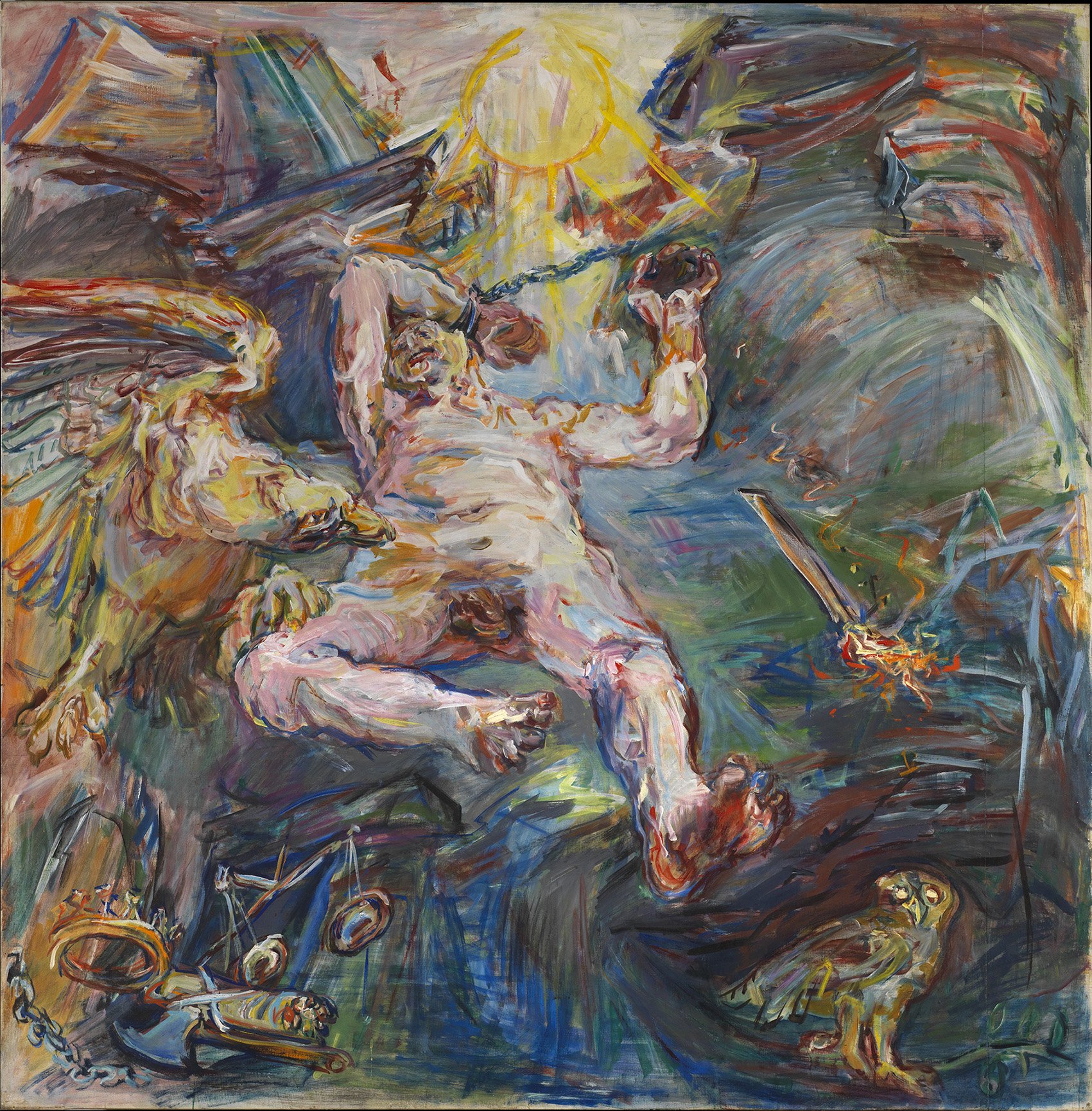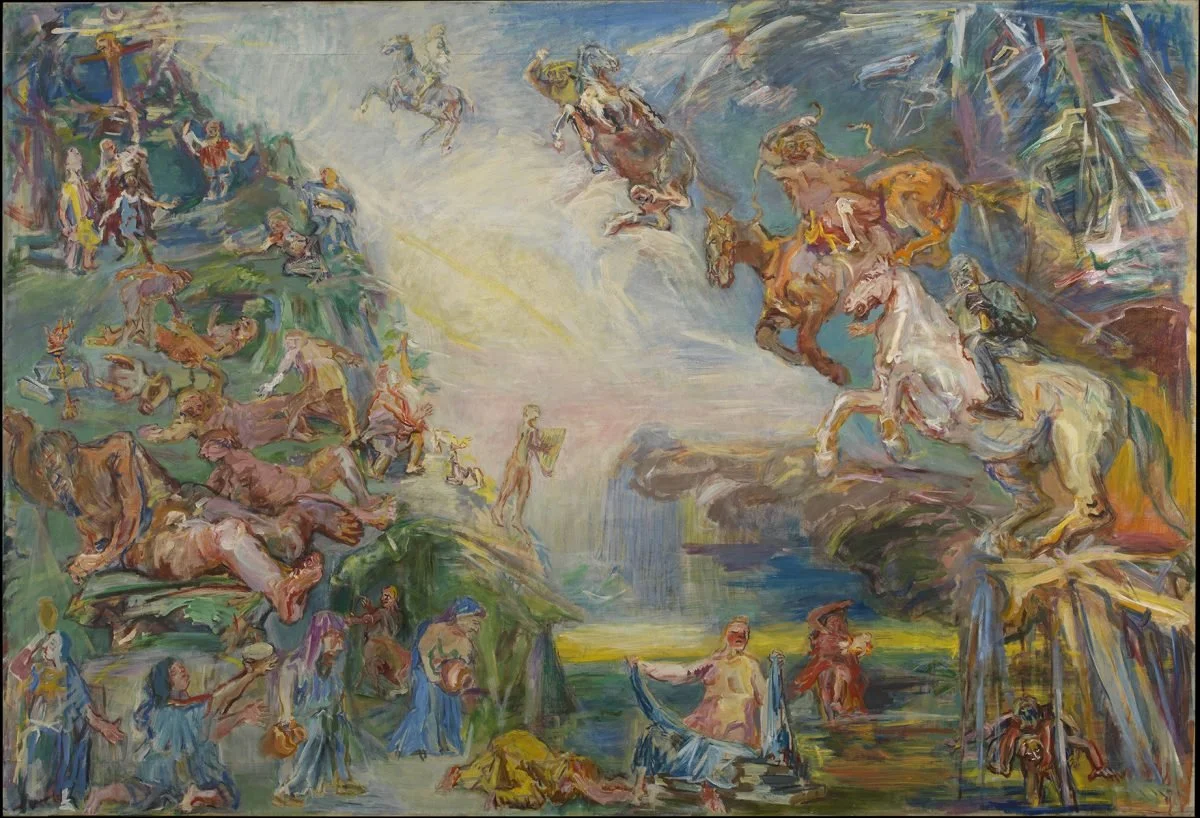The Prometheus Triptych by Oskar Kokoschka at the Courtauld by Molly Hunloke
At the turn of the 20th century an 18 year-old Oskar Kokoschka (1886-1980) had just been granted entry to Vienna’s School of Applied Arts. Vienna’s environment at this time was in the midst of an artistic and intellectual revolution, with the likes of Sigmund Freud developing psychoanalysis and Gustav Klimt at the height of his prominence. Kokoschka’s early love for self-expression came through strongly in his portraits, a medium he began in 1908 and one that he continued throughout his life. Although he was lucky enough to have a number of patrons (including the pioneering modern architect, Adolf Loos) he was strongly criticised by others. Critics described his exhibition room during the polarising Viennese Secession as a “cabinet of horrors”.[1] Kokoschka sidestepped the conventional to depict the intangible beneath the tangible, here evident is the influence of Freud and his analysis of dreams and the unconscious. Coupled with the anxious zeitgeist felt among the bourgeois class about the modern age, Kokoschka was uniquely positioned to become a ‘modern’ artist. By this I mean art that to the modern eye, must and should reach further than simple representation. His disconcerting compositions used sharp lines, bold brushstrokes and strong colours to confront the viewer and encourage them to peer beyond the surface.
Oskar Kokoschka (1886-1980), The Prometheus Triptych - Prometheus, 1950, Foundation Oskar Kokoschka/ DACS 2021
Today at the newly opened (and freshly painted) Courtauld Gallery is The Prometheus Triptych, 1950, it is visible to the public for the first time in over a decade. This piece in particular is a monument to his artistic achievements and is breath-taking in its size and scope. Commissioned by another Austrian, Count Antoine Seilern, who was an avid collector and patron as well as an art historian. The triptych is composed of three huge panels intended to be a ceiling decoration in Seilern’s London home and so would have been seen from below. At the Courtauld they are mounted more comfortably on the walls at a slight angle so that the piece can be seen from a similar angle without needing to crane your neck. The piece takes from Greek mythology, as well as the Bible, with the central and largest panel illustrating the Apocalypse. It includes the four horsemen (conquest, war, famine and death) riding foreshortened into vast, celestial, empty space whilst figures squirm and flail on the ground below. The other two panels are taken from antiquity with the left depicting the Greek goddess Persephone's escape from Hades (interestingly Hades being rendered as a self-portrait), with Demeter, the goddess of harvest and fertility as well as Persephone’s mother, watching on.[2] The final titular panel on the right portrays the punishment of the infamous Titan Prometheus, who secretly took fire from the gods to give to his beloved humans to further their advancement. When he is inevitably caught by Zeus he was chained to a rock and tortured perpetually by an eagle who would swoop down to peck out his liver during the day whilst a new one grew back in the night. It is this last panel I find the most fascinating and also the clearest indicator of Kokoschka’s matchless substance and style.
Although he was a self-confessed stylistic rebel, with The Prometheus Triptych he positioned himself alongside the canon of the Baroque masters like Tiepolo and Rubens, whom he admired. By linking the subject matter and style of this work to the tradition of Western European painting his moralising work feels authoritative and holds more gravity. He paints beautifully mangled, elongated figures from dramatic angles imbued with an emotional intensity and intellect. Kokoschka’s style is unique in its expressionistic quality as well as being astute in its modern use of colour and form, which has led him to be considered as one of the pivotal objective expressionists. This use of colour contributes to the expressionist quality of the work and is the exact element that makes his work so breath-taking. By using bright almost Fauvist colours he creates depth and a contrast between strongly painted figures in the foreground and more softly painted surfaces in the background. The influence of both Van Gogh and Klimt is evident by the pink blubbered flesh of the faces and limbs, dabbled with pale green and creams which aid to make the non-unified surface in his composition standout. The bright yellow and swathes of blue in the writhing figure of Prometheus contrast with the pattern of heavier and stronger colours that make up the claustrophobic background. The viewer has a sense that they could fall into the pictorial space. With slight use of perspective in the foreshortened figure, Kokoschka primarily uses colour to contrast the different surfaces and heighten the emotional intensity of the work.
The other recognisable characteristic in Kokoschka’s work is the use of broad and energetic brushstrokes, which carefully outline his forms. He paints with a wildness that can be seen in the multidirectional strokes and in the texture left by the dry brush. This attack-like style fills the sublime tinged background with violent currents and waves that stay as a constant throughout his other work, barely mellowing. It is this mastery of line that facilitated the triptych to remain as striking now as it would have been 72 years ago. Akin to many other expressionists, Kokoschka forgoes the efforts of colour and form to be harmonious and rather, establishes tempestuous compositions with clashing colours and warped perspectives. This creates an emotional intensity which aims to shake the viewer from bourgeois tedium and conservatism. We can see in his forms that he was not as interested in depicting the physical features of his figures realistically as capturing their (and by extension his) inner psyche. Despite this inclination to abstract, in his eyes in order for art to be as powerful as possible it should still anchor itself to the concrete world in which we live. Again, to our modern eye, art is much more than a beautiful representation of man and his surroundings. To hold a modern audience’s attention art must give the viewer much more than the external view of nature; it should portray emotion and insight. This being the very essence of Kokoschka’s work. With this modern definition of art that he embraced, there was therefore room for an extremely personal form of self-expression too. In this way he was also free of stylistic constraint which only fuelled his belief in the power of art to raise awareness of contemporary problems and anxieties.
The Prometheus Triptych borrows from classical myth, but the titular panel of the triptych is the one in which Kokoschka's quintessential message is best seen. The combination of myth and allegory in Prometheus’s tale stands as a warning to modern society's obsession with science and technology. The pressing urge to evolve for the simple sake of moving forward, no matter the cost, with the potential loss of humanity. Prometheus symbolised humanity’s desire for power beyond its control. He persuaded Seilern to exhibit it at the 1952 Venice Biennale as he intended the work as a public statement. He said the triptych was a warning of the consequences of “man’s intellectual arrogance.” He explained that the dangers faced by contemporary society were represented in the figure of Prometheus, “whose overweening nature drove him to steal fire so that man could challenge the gods.”[3] His concern was rooted in the thought that society was being dominated by science and technology, which threatened the freedom and individuality of mankind. Such fears went on to become widespread panic, exemplified by the Cold War and the Nuclear Arms Race which first developed after the end of World War 2. The Prometheus Triptych can be seen as prophetic of the period that Kokoschka inhabited whilst being startlingly true of ours. We know the overwhelming anxiety and burden of technology all too well because we, like Prometheus, simply cannot responsibly handle it. It is too powerful a tool for us to comprehend, like fire from the gods. Through his work, he attempts and succeeds to shed light on how our base human nature and greed can be easily exposed. Oskar Kokoschka felt that this triptych was the most important work he ever made, its pure emotional energy and psychological insight has made it a welcome addition and stand out piece to Courtauld Gallery.
Oscar Kokoschka (1886-1980), Triptych - Hades and Persephone, 1950. Fondation Oskar Kokoschka/ DACS 2021
Oscar Kokoschka (1886-1980), Triptych - The Apocalypse, 1950. Fondation Oskar Kokoschka/ DACS 2021
Oscar Kokoschka (1886-1980), Triptych - Prometheus, 1950. Fondation Oskar Kokoschka/ DACS 2021
[1] https://www.egon-schiele.net/biography.html
[2]https://courtauld.ac.uk/highlights/the-myth-of%E2%80%AFprometheus/
[3] http://www.artandarchitecture.org.uk/images/gallery/e2b8962a.html



